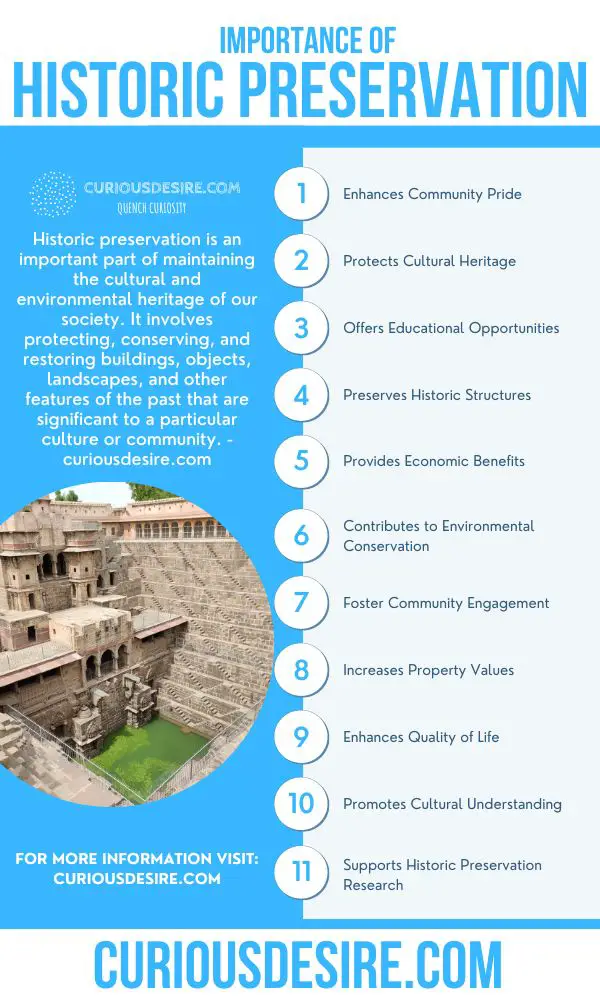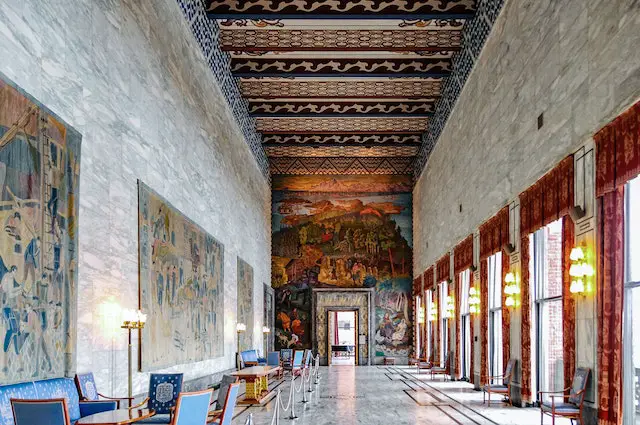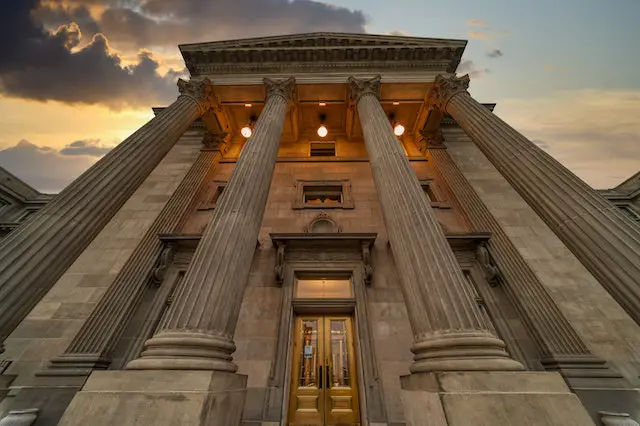Historic preservation is an important part of maintaining the cultural and environmental heritage of our society. It involves protecting, conserving, and restoring buildings, objects, landscapes, and other features of the past that are significant to a particular culture or community.
Historic preservation has many benefits, both tangible and intangible, to our society. In this article, we will discuss 15 reasons for the importance of historic preservation.
15 Benefits of Historic Preservation
Historic preservation is important for many reasons, including:
1. Historic Preservation Enhances Community Pride
Preserving a community’s history can help to create a sense of pride among its residents and visitors. The preservation of local landmarks and historic sites can serve as reminders of the unique aspects that make a place unique.
For instance, by preserving a city’s architecture and monuments, a community can demonstrate its unique identity and culture. This pride can help to attract people to live in the area, as well as attract tourists who are interested in learning more about the community’s history.

2. Historic Preservation Protects Cultural Heritage
Historic preservation helps to protect the cultural heritage of a given area. This is especially important in areas where the culture is threatened due to development or other forms of change.
Preserving and restoring historical sites can help to preserve the cultural identity of an area and provide context for its residents. Without historic preservation, it is possible for an entire culture to disappear over time.
3. It Offers Educational Opportunities
Historical landmarks can serve as learning opportunities for those who visit them. Visitors can gain a better understanding of the past by exploring and interacting with historically significant sites.
Additionally, preserving these sites also provides educational opportunities for future generations. By visiting these sites, children can learn more about the history of their area and gain a greater appreciation for the people and events that have shaped it.
4. It Preserves Historic Structures
Historic preservation is an important way to protect historic structures from destruction or deterioration due to neglect or development. When old buildings are preserved, they can be used for modern purposes while still maintaining their original appearance.
Preserving these structures helps to ensure that the unique characteristics of a place remain intact and are not lost to future generations. Additionally, restored historic buildings often become local attractions and landmarks that draw in visitors from all over the world.
5. Historic Preservation Provides Economic Benefits
Historic preservation can also bring many economic benefits to a community. Restored and preserved sites often become tourist attractions, which in turn result in increased revenue for the surrounding area.
Preserved buildings can also be used as restaurants, shops, or other businesses that generate income for the region. Additionally, historic preservation helps to create jobs related to preservation and restoration activities.
6. It Contributes to Environmental Conservation
The process of restoring historic buildings can also help to contribute to environmental conservation efforts. By using materials that are sustainable or recycled, the process of restoring a building can be made more eco-friendly.
In addition, preserving older structures helps reduce the number of new materials and energy that must be used to construct new buildings. This can help to reduce the amount of pollution generated by construction activities.

7. Historic Preservation Foster Community Engagement
Preserving a community’s history can also help foster greater civic engagement among its residents. By visiting or learning about local historical sites, people are more likely to become more involved in their community.
Additionally, preserving a community’s history can help to create a stronger sense of identity and belonging among residents, which can lead to greater engagement in civic activities.
8. Historic Preservation Increases Property Values
Historic preservation can also help to increase property values in a given area. When an area has numerous preserved sites and monuments, it is more attractive to potential buyers.
The presence of these preserved sites can make the area more desirable for businesses looking to move into the region, resulting in increased economic activity in the area.
9. It Enhances Quality of Life
Historic preservation can help enhance the quality of life in a given area. When people have access to well-preserved historical sites, they are more likely to appreciate and enjoy their surroundings.
In addition, preserving local landmarks can help create an atmosphere where residents feel connected with the past, which can lead to increased pride in the community and a greater sense of satisfaction with their lives.
10. It Promotes Cultural Understanding
Preserving historical sites can help promote cultural understanding among different groups of people. By interacting with and learning about local history, visitors can gain a better appreciation for other cultures that have left an imprint on their surroundings.
This understanding can help to foster greater respect and tolerance among people of different backgrounds, leading to a more peaceful and harmonious society.
11. It Supports Historic Preservation Research
Preserving historical sites can help support ongoing research into the rich history of a given area. By studying and analyzing these sites, researchers can gain valuable insights into past societies and cultures.
This information can then be used to inform the decisions made by current government officials or community members, helping them to better understand their heritage and make more informed decisions about the future.

12. Historic Preservation Preserve Artistic Works
Historic preservation can help to preserve the artwork of the past. By restoring and maintaining old buildings, sculptures, or paintings, future generations will be able to appreciate and learn from these works of art.
This ensures that future generations have access to culture and art from the past, helping them to gain a better understanding of their own history.
13. It Educates the Public
Preserving historical sites can be used as a tool for education and public outreach. By opening these sites to the general public, people can gain an appreciation for their local heritage and learn more about their past.
This educational opportunity helps people understand how different cultures have shaped our current society and can lead to a greater appreciation for the world around us.
14. Historic Preservation Creates Tourism Opportunities

Historic preservation can also create tourism opportunities in a given area. By highlighting preserved sites and monuments, tourists can gain an appreciation for the local history and culture, leading to increased economic activity in the region.
Not only does this provide an additional source of revenue for the community, it also helps to promote understanding between different cultures, as tourists will have the opportunity to interact with locals and learn more about their culture.
15. It is Strengthening Communities
Preserving local history can help to strengthen communities by creating a sense of identity and cohesion among its residents. When people have a shared connection to the past, it helps create a bond between them and gives them something to rally around. This can lead to increased civic engagement as citizens are more likely to take part in local initiatives and activities.
With this increased engagement, communities can work together to improve their quality of life, creating a more positive environment for everyone.
16. Facilitating Historical Preservation Planning
By understanding the historical significance of a given area, local government officials can use this information to help create comprehensive preservation plans.
These plans can take into account factors such as population growth, climate change, and other environmental factors to ensure that the historical sites are properly maintained. This can help protect these sites from being damaged or destroyed in the future.
In addition, it can also help create a more sustainable approach to development, as preservation plans often involve efforts such as green space initiatives or redevelopment projects that reduce energy consumption and protect the environment.
Conclusion
Historic preservation is an important part of preserving our cultural heritage and promoting a shared understanding of the past. By restoring, protecting, and maintaining historical sites, we can ensure that future generations have access to this invaluable resource.
In addition, preserving these sites can also lead to numerous other benefits, such as increased tourism opportunities or better-informed decision-making from local government officials. With this in mind, it’s clear that historic preservation is an essential part of promoting a positive and vibrant future for all.